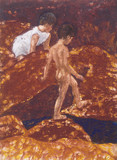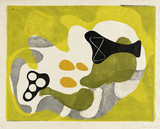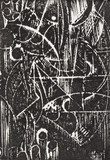Print artist. Onchi was the most important figure in the 'Sosaku Hanga' movement from 1918 until his death, outstanding as a print artist, and active as a poet, founder and editor of magazines, an author on the subject of prints, art and literature, a leader and organiser of societies and encourager of other artists; and in book design, which was his actual profession. He was also the most internationally conscious of all the print artists of the period, in spite of never going to the West and hardly ever leaving Japan.
Onchi was the son of Onchi Tetsuo, an official of the Imperial Court in charge of ceremonies and of the education of two young princes, which education the young Koshiro partly shared. Tetsuo was a calligrapher and scholar of the Chinese language; Onchi Koshiro's mother was a skilled 'koto' player. From 1904 to 1909 he was at the German Cooperative Middle School, as he was intended to be a physician, the profession of his mother's family. Although he dropped out of High School, his knowledge of German gave him a special sympathy with German art, which was to have as a result a major effect on 'Sosaku Hanga'. In 1909 with the reluctant permission of his father he took up Western art studies at the Hakuba-kai (White Horse Society) and in the same year became a friend and student of Takehisa Yumeji (q.v.) who was a major lifelong influence. In 1910 he entered the Tokyo School of Fine Arts but soon dropped out, and by 1911 had secured his first book-designing commission. He rejoined in 1911 but was finally asked to leave in 1915 since he was unable to agree with his teachers. By then he had founded the print and poetry magazine 'Tsukuhae' (1914-15) with Tanaka Kyokichi and Fujimori Shizuo (q.v.) and was working in abstract style prints and poetry. His Lyric series, said to be the first abstract art ever produced in Japan, appeared in the pages of Tsukuhae. Onchi said of Lyric: “All things are driven by life force. Shining with beauty beyond all beauty, this force powerfully binds together every part of our lives. It rushes forth from the depths of the heart. The entirety of our emotions becomes a vibrating form. The heart flows into the hand, and the hand runs over the paper. This is the source of my Lyric series.” (“On the Lyrical in Art,” Emotion no. 20, 1918.)
He married in 1916 (unusually not an arranged marriage). He was a founder-member of the Creative Print Association in 1918, the year he began to work regularly as a book designer. In his career he designed over 1,000 volumes, taking a special interest in Western typefaces and the calligraphy of Chinese characters. The income from this work allowed him to spend time on poetry, prints and the founding, editing and designing of numerous coterie magazines such as 'Shi to hanga' ('Poetry and Prints', 1922-?5) and 'Kaze' ('Wind', 1927-30).
From 1928 he was a leading organiser of the series 'One Hundred New Views of Tokyo' and through the 1930s produced many landscape and figurative prints. In 1934 he published his first art book 'Umi no dowa' (Fairy Tales of the Sea) with all his own illustrations in woodblock and the revolutionary 'Hiko kanno' (Sense of Flight) combining graphic techniques with photographs. He was also a leading organiser for the uncompleted 'One Hundred New Views of Japan' (1938-40). In 1939 he was sent to China as a war artist. His Ichimoku-kai (First Thursday Society, founded 1939) was virtually the only body which kept the Creative Print Movement alive in the later days of the Pacific War.
From 1945 Onchi emerged unequivocally as the leader of the movement and contributed to two of the group portfolios which re-established it ('Tokyo kaiko zue', 1945, and 'Nihon jozoku sen', 1946). His friendship with the American William Hartnett led to the appreciation of his work and that of his pupils in the USA. He exhibited at the São Paolo Biennale in 1951 and became Chairman of the Kokusai Hanga Kyokai (International Print Association). He continued to design books, but the last eight years of his life saw him reverting to pure abstract prints of larger size and increasingly effective colour. Onchi's influence on his younger associates of his later years was very strong, and they dominated printmaking in Japan for another generation (see Hiratsuka Un'ichi, Sekino Jun'ichiro, Yamaguchi Gen, Azechi Umetaro, Takahashi Rikio, Maki Haku, and Yoshida Masaji in Smith 1994).
Bibliography
Smith, Lawrence, 'Modern Japanese Prints 1912-1989: Woodblocks and Stencils', BMP, London, 1994, pp. 32-3 and nos 27-30, 76-80.
Merritt, Helen, 'Modern Japanese Woodblock Prints: The Early Years', University of Hawaii Press, Honolulu, 1990, ch. 8 and passim.
Merritt, Helen, and Yamada, Nanako, 'Guide to Modern Japanese Woodblock Prints 1900-1975', University of Hawaii Press, Honolulu, 1992, pp. 121-2.
Swinton, Elizabeth de Sabato, 'The Graphic Art of Onchi Koshiro', Garland Publishing, New York and London, 1986 (this includes the best biographical information in English, and the most complete bibliography).
Fujii, Hisae, "Onchi Koshiro to Tsukuhae", 'Kindaino bijutsu', 35, Shibundo, Tokyo,1976.
Onchi, Koshiro, 'Onchi Koshiro hanga-shu', Keishosha, Tokyo, 1975, reproduces most of his sheet-prints (but only some in colour).
Kamon, Yasuo, Tozaka, Koji, and Asahi, Akira, 'Shin Tokyo hyakkei', Heibonsha, Tokyo, 1978, reproduce in colour his prints contributed to 'One Hundred New Views of Tokyo'.
Onchi, Kunio, 'Onchi Koshiro hanga-ten', exh. cat., Tokyo, 1987 (a moderately exhaustive account of his book designs).
Statler, Oliver, 'Modern Japanese Prints: An Art Reborn', Turtle, Rutland, Vermont, and Tokyo, 1956, pp. 21-30.
Smith, Lawrence, 'The Japanese Print Since 1900: Old Dreams and New Visions', BMP, London, 1983, nos 14-9, 88a-b, 90.
Smith, Lawrence, Harris, Victor, and Clark, Timothy, 'Japanese Art: Masterpieces in the British Museum', BMP, London, 1990, no 240.
Carey, Frances (ed.), 'Collecting the 20th Century', BMP, London, 1991, p.43.
Centre Georges Pompidou, Paris, 'Japon des Avant Gardes, 1910-1970', exh. cat., 1986 (the items listed as collections of Mrs Evans or Robert Vergez are now in the British Museum).
Onchi, Koshiro, 'Onchi Koshiro hanga-shu', Keishosha, Tokyo, 1975 (the items listed as collections of Mrs Evans or Robert Vergez are now in the British Museum).
British Museum website.
Kōshirō Onchi
11 records
Include records without images
About this artist





